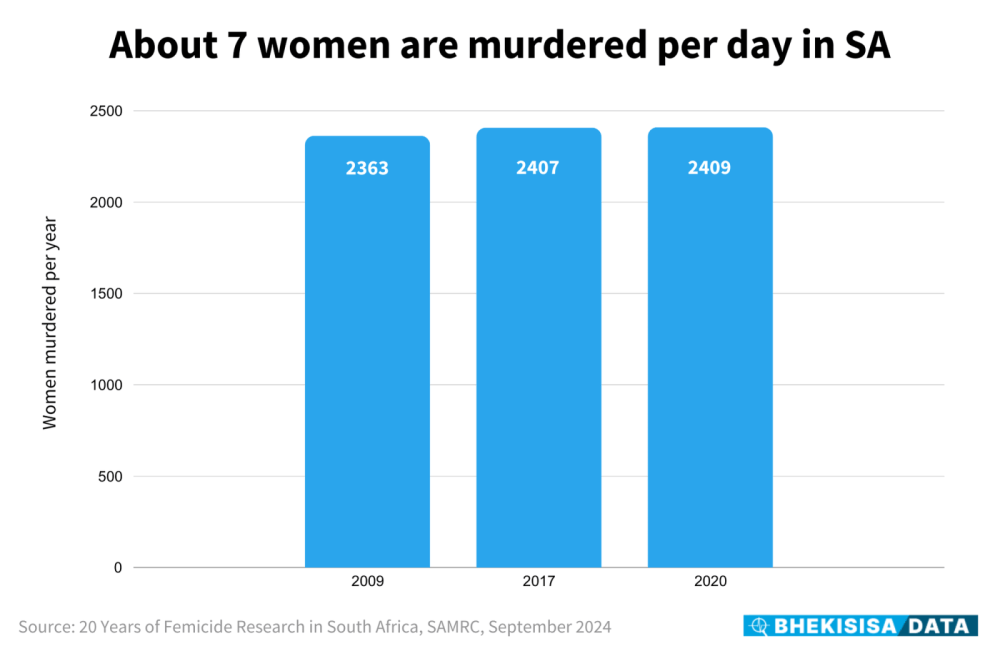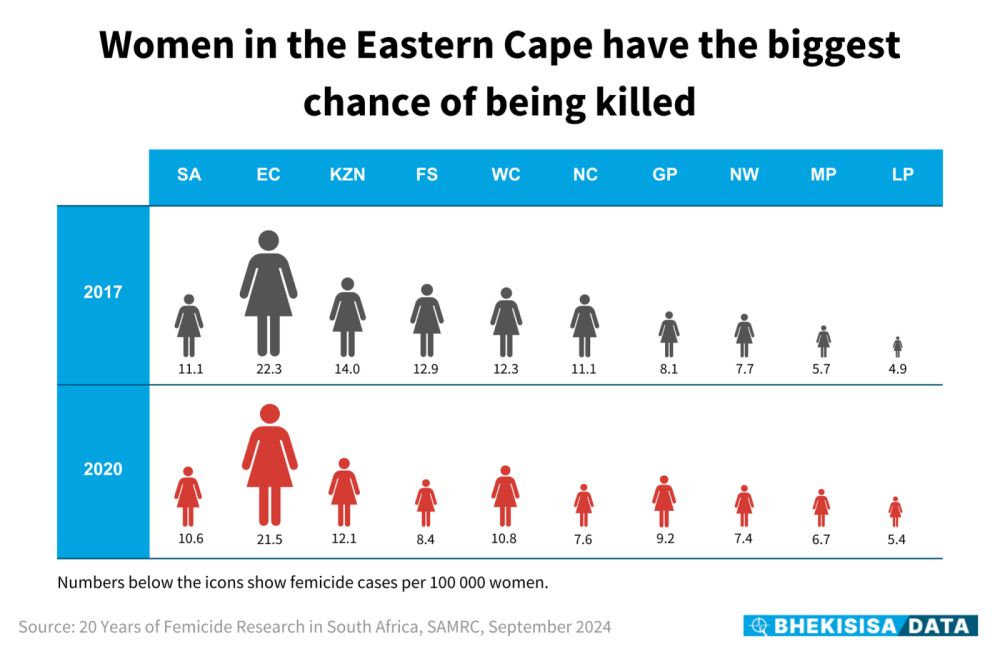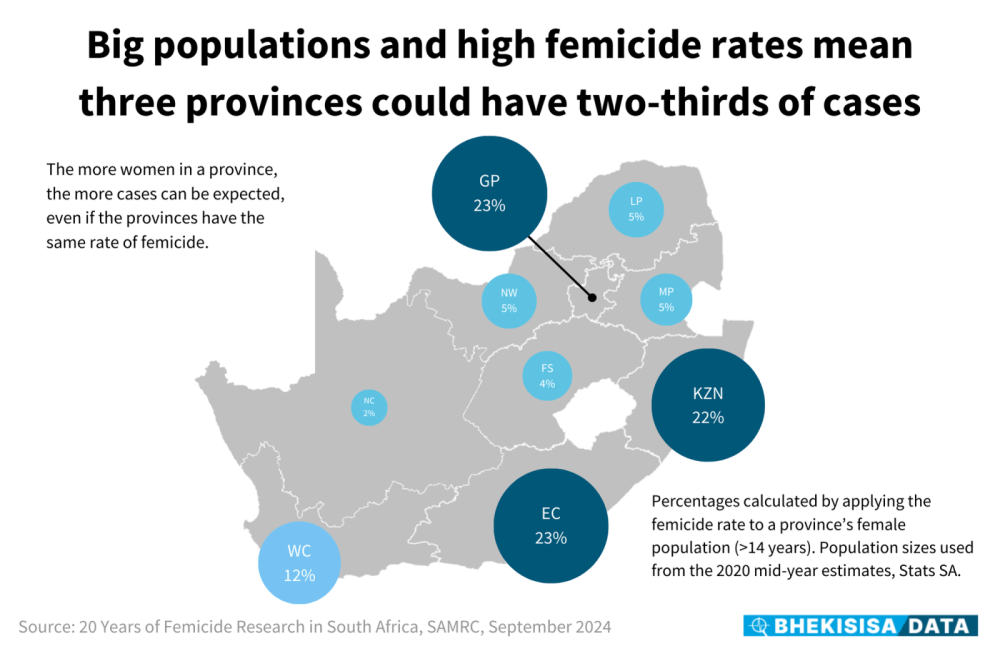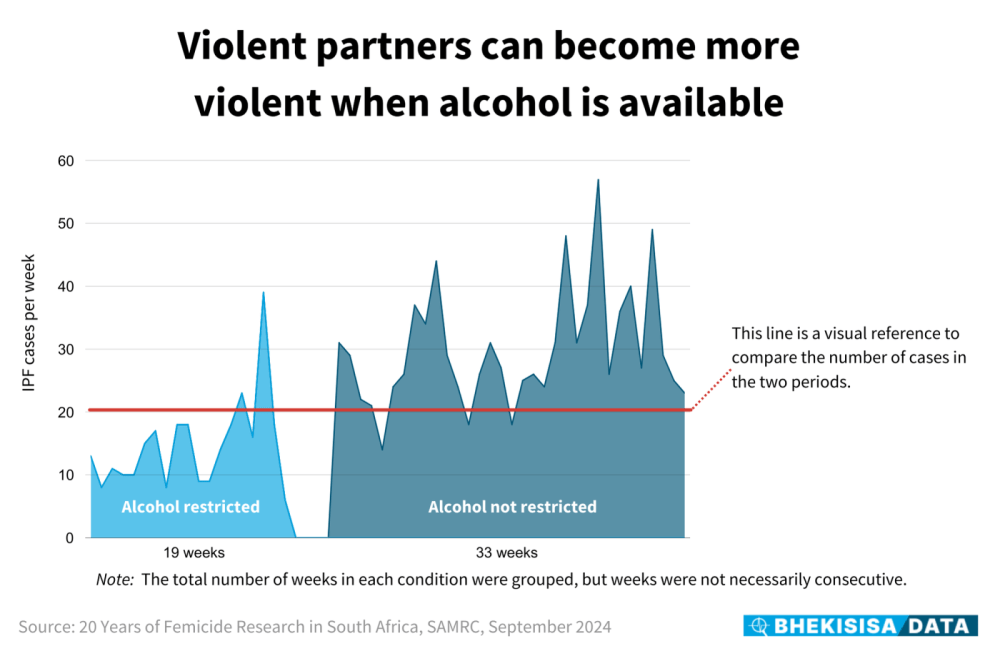There needs to be a balance between protecting privacy and saving lives as South Africa debates publicising its sex offender registry

A woman’s chance of being killed in the Eastern Cape is almost double what it is in the country as a whole, and about half as likely in Limpopo as in the rest of South Africa, results from the South African Medical Research Council’s (SAMRC) fourth survey on femicide, reveal.
The figures were released in Tshwane on Thursday morning.
Seven women are killed in the country each day, and nearly six in 10 of such murders in South Africa are at the hand of a husband, boyfriend or lover — with the needle having hovered around this level for about 10 years. Moreover, it looks like this number — what researchers call cases of intimate partner femicide — seem to be creeping up.
Previous survey results were released in 1999, 2009 and 2017.
Results from the fourth survey, in 2020, show that the country’s overall femicide rate now sits at 10.6 per 100 000 women, which is only slightly lower than the 11.1 per 100 000 in 2017. The rate for intimate partner femicide is at 5.5 — almost five times higher than in the rest of the world then.
The latest results show Gauteng has seen a statistically significant — read, worrying — jump in its overall femicide rate from 8.1 per 100 000 in 2017 to 9.2 per 100 000 now.
Counting the number of murders of women in the country over many years, each time using the same method, is giving the government a gauge to see how things are changing — or not.
Instead of relying on police reports, the SAMRC team has, between 1999 and 2020, looked at how many murdered women are recorded at mortuaries in the country because, by law, the state must do an autopsy in every case when someone dies because of an unnatural reason, like a murder.
The latest survey looked at cases at about half the country’s mortuaries, which is “a huge sample”, says the study’s principal investigator Naeemah Abrahams, and so makes the data representative.
Running the survey a fourth time gives a clearer picture — and, unfortunately, says Abrahams, the numbers appear “more volatile” now.
We dive into what the data shows.
Seven women killed in SA every day
A woman being murdered simply because she is female is the most extreme form of gender-based violence, says the UN — and has been called a crisis in South Africa for almost 20 years.

Around 2 400 women are murdered in the country every year, the last decade’s numbers show, and in 1998 already, data from three provinces showed that a quarter of women were physically or sexually abused by their partners at least once during their life.
The flat overall trend over the last three national surveys and the uptick in intimate partner killings are not what the country wants to see, says Abrahams — especially after cases dropped sharply between 1999 and 2009.
In that time, numbers came down from around 3 800 murders in a year to about 2 400, which worked out to roughly three fewer women being killed per day than when the first survey was run.
But research like this is about “way more than just counting cases”, says Abrahams. “Hearing about a woman being killed in a community is real and our study connects [the numbers to] that experience.”
Comparing numbers
Even though the total numbers seem to stand still, researchers saw by 2017 that things were “going in the right direction” when they worked out how many women were murdered per 100 000 of the female population.
This is called the femicide rate and is a more meaningful way to make sense of the numbers because it’s a way to understand the counts, given the size and growth of the population.
For example, say two women are murdered in a year in place A and six in place B. By looking only at the total numbers, it would seem as if things are worse in place B. However, place B has a female population of 600 000, whereas there are only 100 000 women in place A. This means that out of every 100 000 women, two were killed in A but only one in B.

Rates are going down in some places but up in others and the number of murders by intimate partners is creeping up. Even when rates seem to be dropping, explains Abrahams, it doesn’t look like it can be confidently linked to people’s attitude to keeping women safe changing — something scientists call a statistically significant difference.
For example, the country’s overall femicide rate is at 10.6 per 100 000 women, which is only slightly lower than the 11.1 per 100 000 in 2017.
The overall rates are slightly lower in five of the nine provinces compared with the previous survey, more or less the same in one, and up in three. In Gauteng, the jump is statistically significant.
The Eastern Cape’s rate is almost twice the national statistic — with little having changed since 2017. In the Western Cape, the number is about the same as for the country as a whole and in Limpopo the rate is about half.
In practical terms, these numbers mean that a woman’s chance of being killed in the Eastern Cape is almost double what it is in the country as a whole and about half as likely in Limpopo as in the rest of South Africa.
Problem provinces
When Bhekisisa used the rates to work out the estimated number of cases in provinces based on their population sizes, our calculations showed that just over two-thirds of cases would probably have come from three provinces — the Eastern Cape, Gauteng and KwaZulu-Natal. The other six provinces would make up the remaining third, with the rate in most not even being a quarter of what it is in the Big Three.

Although about 57% of women older than 14 years (the same age group as the SAMRC survey looked at) live in these three provinces, their making up 68% of the femicide cases can warn scientists that the problem here might not be simply because the population is proportionally bigger — and help them look for solutions.
Understanding the numbers in this way makes the survey findings even more valuable, because it can help authorities decide where resources like money and staff need to be deployed — and might help the most — to fight femicide.
Not using numbers sensibly leads to baffling decisions, like, for example, the list of gender-based violence hot spots the police put together at the end of 2020 — of which some turned out to be “not spots” — while places that really needed extra services and money were left out.
Lovers kill their partners
Nearly six in 10 women’s murders are at the hand of a husband, boyfriend or lover — and that has been the case for the past decade.

Moreover, the rates for this type of death have increased in five of the nine provinces, with the biggest jumps compared with the 2017 results again in the Eastern Cape and Gauteng, and very little change seen in KwaZulu-Natal.
Although far more men are murdered in South Africa in a year than women — about 5.5 times as many, according to UN data — the balance tips unevenly when it comes to women being murdered by their intimate partners.
This is not different from trends elsewhere in the world but what is worrying is that the rate of this type of killing is about five times higher than elsewhere in the world: 5.5 cases per 100 000 women here, the SAMRC data shows, compared with the world’s average of 1.1 per 100 000.
However, explains Abrahams, because the UN’s definition clumps intimate partners and family members as perpetrators in this category of murder, a direct comparison would be an underrepresentation.
“If we combine murders by intimate partners and family members, the proportion of this type of killings goes to 71% in South Africa, compared with the global [number of around] 56%,” she says.
How alcohol boosts femicide
The upset of life as we knew it during the Covid pandemic provided the research team with “a natural experiment” to investigate how much worse alcohol misuse makes violent men’s behaviour — something research has shown before increases the chance of household violence against women.

Over 19 weeks of alcohol sales being curbed or banned during the pandemic, the number of cases seen per week, based on mortuary reports, appeared to sit below 20. However, when these restrictions were eased, notably more than 20 cases were seen in most weeks.
The analysis adds weight to findings from two previous South African studies that showed that when alcohol didn’t flow freely, unnatural deaths and injuries that led to people ending up in the emergency room, like from violence, murders or car accidents, dropped markedly.
Results like these, says Abrahams, give researchers hope that femicide can be reduced.
“But things need to be fixed on many levels,” she explains. These would include controlling alcohol sales; stricter gun laws and enforcement; helping women to know when they’re in a dangerous relationship and making it easier for them to leave and keep safe and changing society’s thinking and behaviour towards women.
Just like tackling HIV, fighting femicide is a complex issue. Yet the response has to be different.
Says Abrahams: “In dealing with HIV, it was a biological thing — medicine — that made the difference. For gender-based violence, there’s no drug.”
This story was produced by the Bhekisisa Centre for Health Journalism. Sign up for the newsletter.
